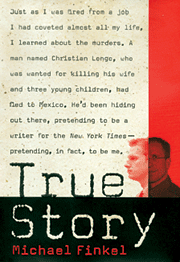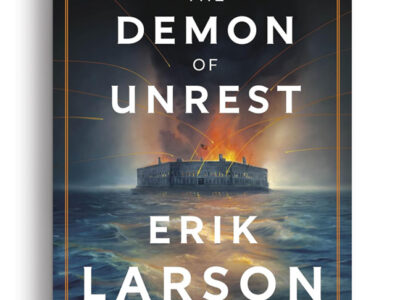How identity theft saved a disgraced journalist’s career.

True Story: Murder, Memoir, Mea Culpa
By Michael Finkel W’90.
HarperCollins, 2005. $25.95.
By Ben Yagoda | Janet Cooke. Stephen Glass. Jayson Blair. Michael Finkel.
Michael Finkel?
You’re forgiven if the final name on this list of journalistic fabricators rings only the faintest bell, or none at all. Unlike Glass C’94 (another Penn alumnus) and Blair—both out-of-control serial offenders—Finkel sinned just once. In that he resembles Cooke, the Washington Post reporter who received a Pulitzer Prize in 1981 for “Jimmy’s World,” an article about an 8-year-old heroin addict who turned out not, in fact, to exist. In 2001, Finkel, a contributing writer for The New York Times Magazine, published in the magazine a long, intimate profile of a Mali teenager who worked on an Ivory Coast cocoa-bean plantation six days a week for a year, sunup to sundown, and received a total of $102 in salary. Several months after the article came out, it emerged that Finkel’s Youssouf Male was, like Cooke’s Jimmy, a “composite character.”
The Times thereupon published, on page A-3 of the daily paper, a 686-word correction detailing Finkel’s sins. It also launched an investigation of the seven other stories he had written for the magazine, and found in them a total of two minor errors. But that didn’t matter. As the correction concluded, “The Times’ policies prohibit falsifying a news account or using fictional devices in factual material. Mr. Finkel has been under contract to the magazine as a contributing writer, but the editors have informed him that he will not receive further assignments.”
This was devastating to Finkel. His relationship with the Times had brought him respect, glory, and prizes; in the words of text on the cover of his new book, True Story: Murder, Memoir, Mea Culpa, his position there was “a job I had coveted almost all my life.” In a way it was the core of his sense of himself. The night before the correction was to appear in the newspaper, the phone rang in his Montana house. On the other end of the line was a reporter for the Portland Oregonian. Finkel logically assumed the man wanted to do an interview about the cocoa-plantation story. But the reporter knew nothing about that. He wanted to talk about a murder suspect who had just been apprehended in Mexico, where he had been passing himself off as Michael Finkel, a writer for The New York Times.
Finkel decided on the spot to tell the story of the suspect, whose name is Christian Longo and who was accused of killing his wife and three small children. For the writer, dreading the prospect of Cooke- or Glass-like professional banishment, the bizarre coincidence was “the journalistic equivalent of a winning lottery ticket.” Not only would he have an exclusive, by virtue of Longo’s having stolen his name, but, if he told the tale with scrupulous honesty, he felt, he might be able to clear his name. The writer got in touch with the suspect, and began a correspondence and series of weekly telephone conversations. The relationship between the two men is one narrative thread of Finkel’s book. The other is the story of Longo’s life and marriage and the events leading up to the murders. The two threads come together in the account of Longo’s trial. (This is as good a place as any to disclose that though I have never met Finkel, he and I have the same literary agent.)
The first words of the dust-jacket copy of True Storyare, “In the haunting tradition of Joe McGinniss’s Fatal Vision … ” An excerpt from True Story was published in the June issue of Vanity Fair, under the title “The Journalist and the Murderer.” These references are no coincidence. Fatal Vision was the non-fiction account of Jeffrey McDonald, the Green Beret doctor who in the 1970s was accused, tried, and ultimately convicted of murdering his wife and two young daughters. The Journalist and the Murderer was New Yorker writer Janet Malcom’s classic investigation of and meditation on the relationship between McGinnis and McDonald and the light it shed on the troubling mutual dependency of reporter and source, and, indeed, on the nature of journalism itself.
True Story suffers in comparison to Fatal Vision not because Finkel is a poor writer; on the contrary, his prose is muscular and economical, his character portraits are often incisive, and the book moves along at a brisk pace. The problem is that Christian Longo is to Jeffrey McDonald as the guy who robs the corner store is to Lex Luthor. Longo is, as Finkel describes him, handsome and intelligent, and in the grips of narcissistic personality disorders, just as McDonald was, but he is also—unlike McDonald—profoundly, fatally, two-bit. He doesn’t offer Finkel, his lawyers, or anyone else a credible explanation of why he fled to Mexico, or any explanation of how his family may have perished, if not by his hand. Finkel gamely tries to generate some suspense (for example, withholding some particularly damning details about Longo till the end of the book), but to this reader, at least, the only mystery was in the details of the crime.
So what True Story ultimately offers is a portrait of a cold-blooded killer. What’s interesting in this regard is not the gruesome details of the crime, but the tangled web of lies, scams, and crimes that Longo wove in the several years leading up to it. Finkel presents us with a sociopathic crook for the digital age. Longo, raised as a Jehovah’s Witness, starts a business that appears to be successful, but is troubled by cash-flow problems. Living way above his means, Longo goes deep into debt and maxes out his credit cards. Armed with his computer, scanner, and laminator, he then perpetrates an amazing range of schemes, from identity theft, to forgery, to embezzlement.
It would probably take a modern-day Dreiser, or at least a Tom Wolfe, to do justice to this cheaply tragic tale. But Finkel reports the story with an attention to credible and specific detail that should, at the very least, give him an early release from journalistic purgatory.
One other element of True Story is of interest—to anyone who cares about journalism, that is. This is the cautionary tale, told in the first 30 or 40 pages, of how Finkel came to fabricate his cocoa-plantation story. He had made his reputation at the Times Magazine with a riveting, and completely true, story of sharing a boat with some Haitian refugees trying to escape to the U.S. The article brought him glory and a contract with the magazine, but also an implicit directive that subsequent pieces must match if not top its news value, color, and drama. Cooke, Glass, and Blair also felt such expectations. The trouble is that reality is not always colorful, dramatic, and explosive.
Finkel was sent to Africa because reports of slavery had begun filtering out. When he got there, he concluded that aid organizations had exaggerated the real abuses and trained boys to tell ginned-up tales of bondage; they (rightly) felt that Western news organizations would feel that the truth wasn’t colorful, dramatic, or explosive enough to cover. Finkel’s account of his gradual realization that he was being played is absorbing; the best scene in the book comes when the third or fourth African teenager in a row tells him the same story, in more or less the same words, of being beaten and whipped. Finkel asks him to take off his shirt. He does so, revealing a back as smooth and untouched as a baby’s bottom.
After Finkel returns to New York, he meets with his editor at the Times and tells her he wants to write about the deception he has uncovered. He was absolutely right. It is a great story. But the editor, in Finkel’s account, said “she wasn’t particularly interested in yet another story accusing the media of getting everything wrong.” Instead, she wanted him to “go literary” with “an intimate portrait of a single laborer.” Finkel writes:
There was some part of me that knew, right then, that I could not fulfill my editor’s request. I should have said so immediately. But I sensed that my success as a writer was almost solely in [the editor’s] hands, and I felt a powerful need to please her.
And so he created his composite character.
Finkel was perhaps more eager to please and to succeed than most journalists. His editor, on this day, made what might seem to be an especially bad call in not letting him go ahead with his original idea. But the basic scenario—reporters and editors knowing that stories that create buzz by whatever means necessary will boost their careers like nothing else—persists. As long as it does, new names will continue to join Cooke, Glass, Blair, and Finkel in the journalistic Hall of Shame.
Ben Yagoda G’91, an associate professor at the University of Delaware, is the author of The Sound on the Page: Style and Voice in Writing, among other books.




